Over the past year, Google searches for generative AI have exploded. Thoughts and discussions about AI (Artificial Intelligence) and ChatGPT are everywhere, permeating every industry. People have countless questions: What does AI mean for businesses? How do I use it? Will my job get replaced by AI?
While generative AI is a somewhat unexplored territory, it has already been put to use. The supply chain has leveraged generative AI for various advancements – and there is still untapped potential.
Ecommerce businesses that have yet to capitalize on AI's capabilities risk losing their competitive edge. However, there are still questions about how to use it safely. In this article, we’ll cover uses for generative AI in the supply chain and how to ensure you’re using it ethically. We’ll also discuss the challenges of adopting AI.
What is generative AI?
Generative AI is artificial intelligence technology that produces a variety of content, such as text, imagery, synthetic data and audio. Generative AI learns patterns and structures of input training data to generate new data with similar characteristics.
Let’s look at generative AI in action. When you type “what is generative AI?” into ChatGPT (an implementation of generative AI), this is what generates:
“Generative AI involves systems, like Generative Adversarial Networks (GANs), that generate new content using machine learning. It includes image, text, audio, and video generation. GANs, with a generator and discriminator, are common in this field. Applications range from image and text creation to voice synthesis and data augmentation. While promising, generative AI also raises ethical concerns due to potential misuse, such as deepfakes, necessitating responsible development and usage.”
Generative AI is used in numerous ways daily:
- Content augmentation and creation
- To locate answers based on data
- To adjust text tone
- To summarize
- For creating outlines and extracting key content
- For chatbot performance improvement
- To code software
- Transforms vast amounts of data into comprehensible summaries
- Uses synthetic data to predict scenarios
New uses are being developed constantly for different fields: In healthcare, automotive, banking, gaming, education, translation and the supply chain.
How is AI used in the supply chain?
Supply chains act as a pillar for ecommerce retailers. They choreograph a complex system of procurement, production, distribution and logistics. The supply chain has seen some major disruptions over the past five years, particularly during the pandemic. It shined a light on potential future issues and spurred experts to look at ways AI could help.
Recently, Harvard Business Review shared their research about how major global companies use AI to future-proof against supply chain disruptions – and several retailers outlined how they have used AI. Here are some of the basic to advanced ways AI has been incorporated into the supply chain:
Supplier analysis: Existing and potential
Today’s customers expect available products and timely delivery. Capacity constraints, customs clearance and transportation issues can all cause delays. However, diversifying suppliers builds resilience.
AI provides two options for supplier analysis: You can use it to assess if existing suppliers can provide additional materials, or you can use it to find alternative supply sources through generated lists of potentials.
AI has been used to dig through granular data to find extra sourcing options within an existing supplier network. It can also deep search the web to build a list of potential suppliers to contact based on finances, customer ratings, awards, customs documents, news feeds, social media and more.
Risk management
AI's predictive capabilities help logistics companies identify potential supply chain risks. This could be economic, weather-related, unstable political regions and other trending factors. Generative AI recommends mitigation strategies for businesses to consider.
Another area for reducing risk is equipment maintenance and using prediction for preventative maintenance. By proactively creating a predictive maintenance plan, logistics operations can minimize unplanned downtime.
Automating negotiations
Automated negotiations can be used for transportation rates or procurement. Companies that have time constraints, multiple contracts and numerous suppliers often lose opportunities, like finding better rates or securing new quotes, especially when bandwidth is limited. New software products use AI to help retailers search for rates within existing agreements or identify where quotes are needed. AI also allows them to reach suppliers they might not otherwise be able to. As MIT describes: Automating negotiations increases the number of suppliers and negotiation rounds, saving money and increasing productivity compared to traditional person-to-person negotiations. While not widely adopted, using automated negotiations is likely on the horizon for the supply chain.
Customer service automation
Customer service automation is a safe and effective use of generative AI for both brands and logistics companies. Customer support teams are often overwhelmed with numerous inquiries, such as order tracking or technology troubleshooting. With generative AI tools like chatbots or virtual assistants, many of these requests can be resolved without a customer support agent.
Implementing AI within customer service can reduce response times and lower support costs. This, in turn, increases customer satisfaction and allows support personnel to focus on more complex inquiries.
Implementing AI
Generative AI can come at a high cost, and ecommerce retailers don’t always have the internal expertise to handle it. But if you are able and prepared to implement AI, consider the following steps:
- Test the technologies: Ensure they’re the right solution and fit within your existing tech stack. Look for security risks and if the software meets your ethical standards.
- Know when AI isn’t necessary: It’s easy to want to make things less manual and more efficient and accurate. However, AI isn’t always the solution. Consider the benefits and whether if using AI would replace valuable partnerships.
- Create an integrated tech stack: Currently, no unified AI solution exists. Build your AI portfolio carefully so that your tools complement each other. Look at accuracy, tasks and risk.
When used safely and ideally, generative AI can save costs, optimize delivery times and help ecommerce businesses diversify their supply chain and remain resilient. Not only will it help brands keep a competitive edge, but it will also let them offer more adaptive, sustainable and customer-focused fulfillment, with every order.
Stay tuned for more on how Cart.com leverages AI.
Subscribe to our emails for the latest industry insights!
By entering your email, you agree to receive marketing emails from Cart.com






